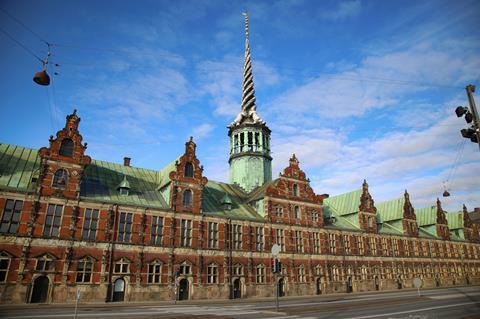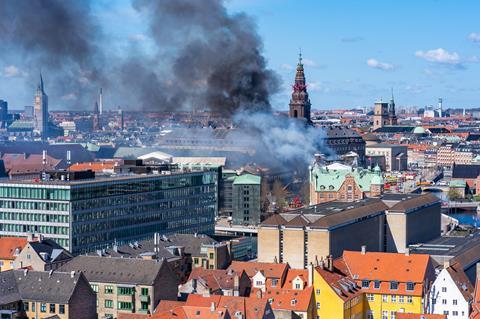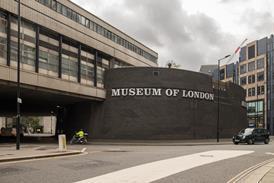The fire at Copenhagen’s historic stock exchange is a reminder that we need to value traditional building skills as much as the buildings themselves, writes Liz Smith

The latest sad sight in a long line of disasters, Copenhagen’s historic stock exchange was ravaged by fire earlier this month whilst restoration works were being carried out. Although it is too early to know the cause, there is a well-established link between fires in heritage buildings and construction work. Although it’s been asked many times before, we find ourselves yet again wondering how these catastrophes can be avoided.
Research carried out by Historic England in 2019 found that over 1,000 incidents in the historic built environment required fire and rescue services. A recent article by Richard Milne in the Financial Times noted that worldwide, one historic building is damaged by fire every day.
Despite the 1990 report Heritage Under Fire, it wasn’t until 1992, when a catastrophic fire ravaged 100 rooms at Windsor Castle that widespread national action was brought to this issue. The loss of one of the nation’s most significant historic treasures was enormously significant, and the message hit home hard. The Bailey report, released in the wake of the Windsor Castle fire, concluded that the main issues were:
- The need for effective training of all staff in basic fire risk management and the actions to take in case of fire
- The need for the earliest possible detection of fire by a reliable automatic fire warning system
- The need for fire separation or compartmentation to reduce the spread of fire
Despite the logistical difficulties involved with their physical implementation, the second and third of these have largely been achieved across historic buildings of all creeds and grade listings. The first, however, with particular emphasis on the ‘effective’ element, appears to have been avoided on any scale that could make a meaningful difference. But is education the answer? And if so, what is it we really need to learn?

At Purcell, we provide a pot of over £250,000 annually for our employees to learn and develop their skills and knowledge through a plethora of courses, accreditations and qualifications. We see this education, particularly in conservation, as fundamental to our success as a practice, and an important part of how we build our reputation in the heritage sector.
We are most keen to encourage the learning of skills and techniques that have been in existence for hundreds of years, as we believe that the knowledge of materials and crafts that made our heritage, are also the key to preserving and protecting it.
Milne’s article in the FT is supportive of this notion, suggesting that complacency is still a huge problem. I do wonder if we were still training our young people in traditional crafts such as stonecutting and wood carving, whether there might be a more ingrained respect for the creativity and skill that is embodied in these fine buildings. As a society we have turned a blind eye to the skills that were once among the most well paid and coveted manual jobs up and down the country.
Reading Ben Flatman’s recent opinion piece in Building Design about the lack of ornamentation in architecture in the 20th century, was a reminder of the loss of diversity and cultural references in contemporary architectural language. Historic England defines cultural heritage as ‘Inherited assets which people identify and value as a reflection and expression of their evolving knowledge, beliefs and traditions.’ Over the last hundred years, Western architectural training has focused on the principles of Modernism.
>> Also read: Is the lack of ornament in architecture a barrier to diversity?
Architectural students who are interested in vernacular and decorative approaches have struggled to find their way through the architectural education system. A consequence of this is the chronic lack of architects - and therefore of skilled craftspeople - who can design, build, repair and look after buildings that reflect a broader, plural cultural heritage. It is a tragic irony that we are forced to rely on disasters for opportunities to train new master craftspeople and upskill fully qualified architects to learn skills that were omitted from their seven year design education.
We often hear of contemporary tools such as hot torches and halogen lamps being used on heritage buildings. If we had continued to nurture skills more widely as part of our everyday construction industry, would there be a more innate understanding of the fabric of heritage buildings, instead of this knowledge being a niche subset of the building industry? If this knowledge was handed down through generations, would we have a less risky mindset when it comes to working with aged materials? Would there be more respect for intricately carved joinery if more people on site had been better educated in traditional materials and techniques?

A new HSE (heritage and safety executive)?
Human error is often found to be a significant factor in fires starting on site. Better training in awareness and basic safety must be prioritised in the form of nuanced, material-focused knowledge for historic buildings.
Historic buildings were not designed to meet modern building codes, making them vulnerable to many disasters, but particularly so during restoration work. Often constructed with timber supports which would these days be fire resistant, the old, dry beams, surrounded by cavernous roof voids, can create a tinderbox.
When the Notre Dame fire broke out in 2019, it was as though part of the soul of Paris was in flames. The media proclaimed it a national disaster, speaking to the enormous value heritage assets have on our sense of collective identity. On top of this is the economic value such iconic sites generate. It is estimated that the heritage sector directly generates 2% of the national gross value added (GVA) to the UK economy. The historic sector employs around half a million people in the UK and attracts millions of domestic and international tourists. In short, it’s not just worth investing in the future of heritage because we love and cherish it, but also because it is a vital part of our national economic model.
>> Also read: Notre-Dame ‘will be rebuilt’ after devastating fire
>> Also read: Rebuild the Mack, but why stop there?
Postscript
Liz Smith is chairperson of Purcell and the regional partner for London and the South East
















3 Readers' comments